German bombing of Rotterdam
The German bombing of Rotterdam, also known as the Rotterdam Blitz, was the aerial bombardment of Rotterdam by the Luftwaffe on 14 May 1940, during the German invasion of the Netherlands in World War II. The objective was to support the German troops fighting in the city, break Dutch resistance and force the Dutch army to surrender. Almost the entire historic city centre was destroyed, nearly 900 people were killed and 85,000 more were left homeless.
| The Rotterdam Blitz | |||||||
|---|---|---|---|---|---|---|---|
| Part of the German invasion of the Netherlands | |||||||
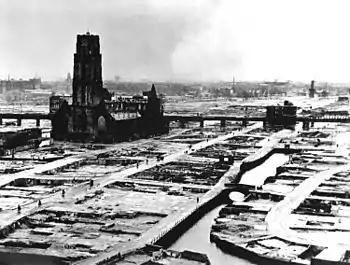 Rotterdam's city centre after the bombing. The heavily damaged (now restored) St. Lawrence church stands out as the only remaining building which is reminiscent of Rotterdam's medieval architecture. The photo was taken after the removal of all debris. | |||||||
| |||||||
| Belligerents | |||||||
|
|
| ||||||
| Commanders and leaders | |||||||
| P. W. Scharroo | Albert Kesselring | ||||||
| Units involved | |||||||
|
Luchtvaartafdeling (LVA) Marine Luchtvaartdienst (MLD) | Luftflotte 2 | ||||||
| Strength | |||||||
| No remaining operational fighter aircraft[1] |
80 aircraft directly involved 700 involved in concurrent operations | ||||||
| Casualties and losses | |||||||
|
884 civilians killed LVA and MLD virtually destroyed[2] | none | ||||||
The psychological and physical success of the raid, from the German perspective, led the Oberkommando der Luftwaffe (OKL) to threaten to destroy the city of Utrecht if the Dutch command did not surrender. The Dutch surrendered in the late afternoon of 14 May, signing the capitulation early the next morning.[3]
Prelude
During the Second World War, the Netherlands' strategic location between Great Britain and Germany made it ideal for the basing of German air and naval forces to be used in attacks on the British Isles. The Netherlands had firmly opted for neutrality throughout the First World War and had planned to do the same for the Second World War. It had refused armaments from France, making the case that they wanted no association with either side. While armament production was slightly increased after the invasion of Denmark in April 1940, the Netherlands possessed only 35 modern wheeled armoured fighting vehicles, five tracked armoured fighting vehicles, 135 aircraft, and 280,000 soldiers,[4] while Germany committed 159 tanks,[5] 1,200 modern aircraft, and around 150,000 soldiers to the Dutch theatre alone.[5]
With a significant military advantage, the German leadership intended to expedite the conquest of the country by first taking control of key military and strategic targets, such as airfields, bridges, and roads, and then using these to gain control of the remainder of the country. The first German plans to invade the Netherlands were articulated on 9 October 1939, when Hitler ordered that "Preparations should be made for offensive action on the northern flank of the Western Front crossing the area of Luxembourg, Belgium, and the Netherlands." This attack was to be carried out as quickly and as forcefully as possible.[6] Hitler ordered German intelligence officers to capture Dutch army uniforms and use them to gain detailed information on Dutch defensive preparations.[7]
The Wehrmacht launched its invasion of the Netherlands in the early hours of 10 May 1940. The attack started with the Luftwaffe crossing through Dutch airspace, giving the impression that Britain was the ultimate target. Instead, the aircraft turned around over the North Sea and returned to attack from the west, dropping paratroopers at Valkenburg and Ockenburg airfields, near the Dutch seat of government and the Royal Palace in The Hague, starting the Battle for the Hague. While Germany had planned to take control swiftly using this strategy, the assault on The Hague failed. However, bridges were taken at the Moerdijk, Dort and Rotterdam, allowing armoured forces to enter the core region of the Fortress Holland on 13 May.
Battle for Rotterdam
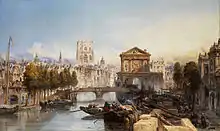
The situation in Rotterdam on the morning of 13 May 1940 was a stalemate as it had been over the previous three days. Dutch garrison forces under Colonel P.W. Scharroo held the north bank of the Nieuwe Maas river, which runs through the city and prevented the Germans from crossing; German forces included airlanding and airborne forces of General Student and newly arrived ground forces under General Schmidt, based on the 9th Panzer Division and the Leibstandarte Adolf Hitler, a motorized SS regiment.
A Dutch counterattack led by a Dutch marine company had failed to recapture the Willemsbrug traffic bridge,[8][9] the key crossing. Several efforts by the Dutch Army Aviation Brigade to destroy the bridge also failed.[10]
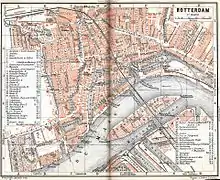
General Schmidt had planned a combined assault the next day, 14 May, using tanks of the 9th Panzer supported by flame throwers, SS troops and combat engineers.[11][12][13][14] The airlanding troops were to make an amphibious crossing of the river upstream and then a flank attack through the Kralingen district.[15][16] The attack was to be preceded by artillery bombardment, while Gen. Schmidt had requested the support of the Luftwaffe in the form of a Gruppe (about 25 aircraft) of Junkers Ju 87 dive-bombers, specifically for a precision raid.[17][18][19]
Schmidt's request for air support reached Berlin, staff of Luftflotte 2. Instead of precision bombers, Schmidt got carpet bombing by Heinkel He 111 bombers besides a Gruppe of Stukas focussing on some strategic targets. The carpet bombing had been ordered by Hermann Göring, to force a Dutch national capitulation.[20]
Bombing
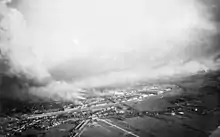
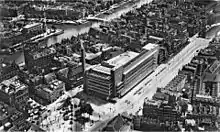
Schmidt used the threat of destroying Rotterdam to attempt to force Colonel Scharroo to surrender the city. Rotterdam, the largest industrial centre in the Netherlands and of major strategic importance to the Germans, was to be bombed. Scharroo refused and stretched out negotiations. The start of the air raid had been set for 13:20 (Dutch time, MET – 1 hr 40).[21][22][23]
Schmidt relented and issued a second ultimatum of 16:20.[24][25] However, it was already too late and just as the Dutch negotiator was crossing the Willemsbrug to relay this information, the drone of bombers was heard: a total of 90 bombers from Kampfgeschwader 54 were sent over the city.[26]
Schmidt radioed to postpone the planned attack. When the message reached KG 54's command post, the Kommodore, Oberst Walter Lackner, was already approaching Rotterdam and his aircraft had reeled in their long-range aerials. Haze and smoke obscured the target and to ensure that Dutch defences were struck, Lackner brought his formation down to 2,300 ft (700 m).[27] German forces on the Noordereiland fired flares[28] to prevent friendly fire — after three aircraft of the southern formation had already unloaded, the remaining 24 craft in the southern bomber formation under Oberstleutnant Otto Höhne aborted their attack. The larger formation came from the north-east. Unable to see the red flares launched from the southern area of the city, they proceeded with their attack. Fifty-four He 111s dropped low to release 97 tonnes (213,848 lb) of bombs, mainly in the centre of the city.[29]
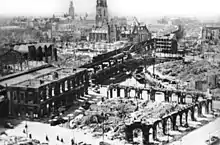
Why the formation did not receive the order to abort sooner remains a subject of some controversy. Oberst Lackner of the largest formation claimed that his crews had been unable to spot the red flares due to bad visibility caused by humidity and the dense smoke rising from burning structures, and that they had consequently needed to drop to 2,000 feet.[30] But the red flares that Lackner failed to see could have also been used by the Germans to show their location in the city and avoid friendly fire. An official German form designated red as the colour to be used for that purpose.[31]
In total, 1,150 50-kilogram (110 lb) and 158 250-kilogram (550 lb) of bombs were dropped on the city, mainly in the residential areas of Kralingen and the medieval city centre. Most of them struck buildings which immediately went up in flames. The fires across the city centre spread uncontrollably and in the subsequent days they were aggravated as the wind grew stronger, merging to become a firestorm.[29] Although the exact number of casualties is not known, nearly 1,000 people were killed and 85,000 were made homeless.[32] Around 2.6 square kilometres (1.0 sq mi) of the city was levelled. 24,978 homes, 24 churches, 2,320 stores, 775 warehouses and 62 schools were destroyed.[33] Schmidt sent a conciliatory message to the Dutch commander General Winkelman, who surrendered shortly afterwards at Rijsoord, a village southeast of Rotterdam.[27] The school where the Dutch capitulated was later turned into a small museum.
Aftermath

The Dutch military had no effective means of stopping the bombers (the Dutch Air Force had practically ceased to exist and its anti-aircraft guns had been moved to The Hague), so when another similar ultimatum was given in which the Germans threatened to bomb the city of Utrecht, the Dutch supreme command in the late afternoon decided to capitulate rather than risk the destruction of another city.[34][35] Dutch and British sources informed the public through Allied and international news media that the raid on Rotterdam had been on an open city in which 30,000 civilians were killed (the real number was around 900) "and character[ised] the German demolition of the old city as an act of unmitigated barbarism".[36] The number of casualties was relatively small, because thousands of civilians had fled to safer parts of Rotterdam, or to other cities, during the previous four days of bombing and warfare.[37] German weekly Die Mühle (The Windmill) stated that the Dutch government was to blame for turning Rotterdam into a fortress, despite multiple summons to evacuate. It also claimed that the old city was ignited by Dutch bombs and incendiary devices.[38]
The United Kingdom had had a policy of bombing only military targets and infrastructure such as ports and railways which were of military importance.[39] While it was acknowledged that bombing of Germany would cause civilian casualties, the British government renounced the deliberate bombing of civilian property outside combat zones (which after the fall of Poland, meant German areas east of the Rhine) as a military tactic. This policy was abandoned on 15 May 1940, one day after the Rotterdam Blitz, when the RAF was directed to attack targets in the Ruhr, including oil plants and other civilian industrial targets which aided the German war effort, such as blast furnaces that at night were self-illuminating. The first RAF raid on the interior of Germany took place on the night of 15/16 May 1940.[40][41]
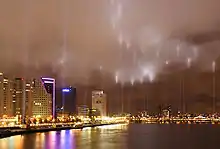
When the invasion of Holland took place I was recalled from leave and went on my first operation on 15 May 1940 against mainland Germany. Our target was Dortmund and on the way back we were routed via Rotterdam. The German Air Force had bombed Rotterdam the day before and it was still in flames. I realised then only too well that the phoney war was over and that this was for real. By that time the fire services had extinguished a number of fires, but they were still dotted around the whole city. This was the first time I'd ever seen devastation by fires on this scale. We went right over the southern outskirts of Rotterdam at about 6,000 or 7,000 feet, and you could actually smell the smoke from the fires burning on the ground. I was shocked seeing a city in flames like that. Devastation on a scale I had never experienced.
— Air Commodore Wilf Burnett.[42]
Reconstruction
Now the biggest bank structure in Europe rears its rounded, balloon-hanger bulk out of the bomb made desert. This is the new home of the Rotterdamsche Bank. Behind its grilled windows flows the golden blood of commerce. Half a mile away, the cement spattered wooden forms of a huge, new wholesale mart climb to knobby squares above the flat sands. Wholesalers already do business on the ground floor while fresh concrete flows into the forms two floors higher. Along the waterfront, a couple of miles down the New Meuse (nieuwe Maas) river, cranes lever the bales and boxes of an industrial world in and out of the new warehouses.
— Cairns Post Newspaper article,1950.[43]
Due to the extent of damage from the bombardment and the resulting fire, an almost immediate decision was taken to demolish the entire city centre with the exception of the Laurenskerk church, the Beurs (trade centre), the Postkantoor (Post Office) and the town hall.[44] Despite the disaster, the city's destruction was regarded as the perfect opportunity to redress many of the problems of industrial pre-war Rotterdam, such as crowded, impoverished neighborhoods,[45] and to introduce broad-scale, modernising changes in the urban fabric which had previously been too radical in built-up city.[46] There seemed to be no thought of nostalgically rebuilding the old city,[47] as it would be at the expense of a more modern future.[48]
W.G. Witteveen, director of the Port Authority, was instructed to draw up plans for the reconstruction within four days of the bombing,[49] and had presented his plan to the city council in less than a month.[45] This first plan essentially used most of the old city's structure and layout, but it integrated them into a new plan, with widened streets and sidewalks.[44][49] The largest and most controversial change in the layout was to move the main dike of the city alongside the riverbank, so as to protect the low-lying Waterstad area from flooding.[45] This was met with criticism from the newly formed Inner Circle of the Rotterdam Club, which promoted integrating the city with the Maas River, and claimed that the dike would create a marked separation from it.[45] A number of new or previously incomplete projects – such as the Maastunnel and Rotterdamsche bank – were to be completed in accordance with Witteveen's plan, and these projects kept the Dutch people in work during the German occupation of the city, until all of the construction was halted.[49] Herman van der Horst's 1952 documentary Houen zo! presents a vision of some of these projects.[50] During this time, Witteveen's successor Cornelius van Traa drafted a completely new reconstruction plan – the Basisplan voor de Herbouw van de Binnenstad – which was adopted in 1946.[44][45] Van Traa's plan was a much more radical rebuild, doing away with the old layout and replacing them with a collection of principles rather than such a rigid structural design.[49] The Basisplan placed a high emphasis on broad open spaces and promoted the river's special integration with the city through two significant elements; the Maas Boulevard, which re-imagined the newly moved dike as an 80m wide tree-lined street; and the Window to the River, a visual corridor running from the harbour to the centre of the city.[45] Both were meant to show the workings of the harbour to the city's people.
Because reconstruction work began so rapidly after the bombing, by 1950 the city had again retained its reputation as the fastest loading and unloading harbour in the world.[51]
Around the same time, the city centre of Rotterdam had shifted north-west as a result of temporary shopping centres which had been set up on the edge of the devastated city,[45] and new shopping centre projects like the Lijnbaan were expressing the radical new concepts of the Basisplan, through low, wide open streets set beside tall slab-like buildings.[48] Rotterdam's urban form was more American than other Dutch cities, based on US plans,[48] with a large collection of high-rise elements[44] and the Maas boulevard and Window to the River functioning primarily as conduits for motor vehicles.[45] In later years, Rotterdam architect Kees Christiaanse wrote:
Rotterdam did indeed resemble an American provincial city. You could drive leisurely in a big car through the broad streets and revel in the contrasts between emptiness and density. The Rotterdam police drove around in huge Chevrolets...and the Witte Huis was the first high-rise building in Europe with a Chicago-type steel skeleton and a ceramic façade.
— Kees Christiaanse, Rotterdam.[52]
This larger-scale, 'wholesale-quantity' approach was equally used for hospitals and parks (such as Dijkzigt Hospital and Zuider Park) as retail centres,[49] but close attention was still paid to creating human-scale, walkable promenades, especially that of the Lijnbaan, which presented broad sunny walkways for shoppers and spectators, and tried new retail techniques such as open glass walls to blend interior and exterior.[48]
While urban reconstruction can be fraught with complexity and conflict,[46] Rotterdam's status as a 'working' harbour city meant it did not receive the same resistance to rebuilding as a cultural or political centre (as Amsterdam or The Hague) might have.[49] However, there was still significant movement of people away from the city centre during Rotterdam's reconstruction to purpose-built neighbourhoods such as De Horsten and Hoogvliet, which are now inhabited by mainly lower-income households.[53]
Today, van Traa's Basisplan has been almost completely replaced with newer projects. For example, The Maritime Museum blocks the Window to the River, and Piet Blom's Cube Houses create another barrier between the city and the river, where in the Basisplan there was to be a connection between them.[44] The Euromast tower which was built in 1960, is a related attempt to create a visual link between the city and the port, seemingly one of the last architectural structures which is related to van Traa's Basisplan[45] before later attempts like the Boompjes Boulevard in 1991.[54]
See also
Notes
- De luchtverdediging mei 1940, by F.J. Molenaar. The Hague, 1970.
- Hooton 2007, p. 79.
- Hooton 2007, p. 52.
- Goossens 2011, Dutch army unit organisation.
- Goossens 2011, German strategy 10 May 1940: German invasion army strength
- The Nizkor Project 1991, p. 766.
- Foot 1990, p. .
- Brongers 2004, (ONR Part III), p. 83
- Amersfoort 2005, p. 364.
- Brongers 2004, (ONR Part I), pp. 242,243
- Brongers 2004, (ONR Part III), pp. 204, 205
- Amersfoort 2005, p. 367.
- Pauw 2006, p. 75.
- Götzel 1980, p. 145.
- Götzel 1980, p. .
- Kriegstagebuch, KTB IR.16, 22.ID BA/MA
- Brongers 2004, (ONR Part III), p. 201
- Amersfoort 2005, p. 368.
- Götzel 1980, pp. 146, 147.
- Goossens 2011, Rotterdam: Introduction – a recapitulation; Brongers 2004, (ONR Part III), p. 232; Amersfoort 2005, pp. 368,369;Pauw 2006, p. 74; Götzel 1980, pp. 146–151; Lackner 1954, p.
- Brongers 2004, (ONR Part III), p. 235
- Amersfoort 2005, p. 369.
- Götzel 1980, pp. 149, 150.
- Brongers 2004, (ONR Part III), p. 227
- Amersfoort 2005, p. 370.
- Brongers 2004, (ONR Part III), p. 232; Lackner 1954, p. ;Amersfoort 2005, p. 369; Pauw 2006, p. 84; Speidel 1958, p.
- Hooton 1994, p. 249.
- Jong 1940, p. 352.
- Goossens 2011, May 14: Rotterdam; Amersfoort 2005, p. 370; Pauw 2006, p. 84; Hooton 1994, p. 249; Brongers 2004, (ONR Part III), p. 236; Götzel 1980, p. 151; Lackner 1954, p. ; Wagenaar 1970, pp. 307–308
- Lackner 1954, p. .
- L. Elfferich, Rotterdam werd verraden. Abcoude: Uniepers, 1990. p. 270
- Nederlands Omroep Stichting (NOS) 2008.
- Roep & Loerakker 1999, p. 42 Square 2.
- Brongers 2004, (ONR Part III), p. 263.
- Amersfoort 2005, p. 183.
- Hinchcliffe 2001, p. 43; DeBruhl 2010, pp. 90–91 and Grayling 2006, p. 35 for the quote.
- Wagenaar 1970, pp. 75–303.
- Die Mühle, no.22, 31 May 1940, Moritz Schäfer Verlag, Leipzig
- Hastings 1999, pp. 54–56.
- Grayling 2006, pp. 23–24.
- Taylor 2005, Chapter "Call Me Meier", p. 111.
- Burnett 2008.
- Cairns Post 1950.
- Christiaanse 2012, pp. 7–17.
- Meyer 1999, pp. 309–328.
- Diefendorf 1990, pp. 1–16.
- Cairns Post 1950.
- Taverne 1990, pp. 145–155.
- Runyon 1969.
- Horst 1952.
- Nambour Chronicle and North Coast Advertiser 1950.
- Christiaanse 2012, pp. 19.
- Kleinhans, Priemus & Engbersen 2007, pp. 1069–1091.
- Christiaanse 2012, pp. 46.
References
- Amersfoort, H; et al. (2005), Mei 1940 – Strijd op Nederlands grondgebied (in Dutch), SDU, ISBN 90-12-08959-X
- Brongers, E.H. (2004), Opmars naar Rotterdam (in Dutch), Aspect, ISBN 90-5911-269-5
- Burnett, Wilf (7 October 2008), "Flying over Rotterdam", Early Days, Personal Stories, Bomber Command Association, archived from the original on 21 January 2016, retrieved 16 August 2017
- "Rotterdam Rises Again", Cairns Post, Queensland, Australia, p. 2, 2 March 1950
- Christiaanse, Kees (2012), Rotterdam, Rotterdam: 010 Publishers, ISBN 978-90-6450-772-4
- DeBruhl, Marshall (2010), Firestorm: Allied Airpower and the Destruction of Dresden (unabridged ed.), Random House Publishing Group, pp. 90–91, ISBN 9780307769619
- Diefendorf, Jeffry M. (1990), Rebuilding Europe's bombed cities., Basingstoke: Macmillan, ISBN 0-333-47443-0
- Foot, M.R.D. (1990), Holland at war against Hitler: Anglo-Dutch relations, 1940-1945, ISBN 978-0-7146-3399-2
- Goossens, Allert (2011), Welcome, website of 1998-2009 Stichting Kennispunt Mei 1940
- Götzel, H (1980), Generaloberst Kurt Student und seine Fallschirmjäger (in German), Podzun-Pallas Verlag, ISBN 3-7909-0131-8, OCLC 7863989
- Grayling, A.C. (2006), Among the Dead Cities, London: Bloombury, ISBN 0-7475-7671-8
- Hastings, Max (1999), Bomber Command, London: Pan Books, ISBN 978-0-330-39204-4
- Hinchcliffe, Peter (2001) [1996], The other battle: Luftwaffe night aces versus Bomber Command, Airlife Publishing, ISBN 978-1-84037-303-5
- Hooton, Edward (1994), Phoenix Triumphant; The Rise and Rise of the Luftwaffe, London: Arms & Armour Press, ISBN 1-86019-964-X
- Hooton, Edward (2007), Luftwaffe at War; Blitzkrieg in the West, London: Chevron/Ian Allan, ISBN 978-1-85780-272-6
- Jong, dr. L de (3 May 1940), Het Koninkrijk der Nederlanden in de Tweede Wereldoorlog deel (in Dutch), p. 352
- Horst, Herman van der (1952), Houen zo! (in Dutch)
- ?. Kriegstagebuch IR.16, May 1940
- Kleinhans, R.; Priemus, H.; Engbersen, G. (2007), Understanding Social Capital in Recently Restructured Urban Neighbourhoods: Two Case Studies in Rotterdam., 44, Urban Studies (Routledge), pp. 1069–1091
- Lackner, a.D. (Gen-Lt) (1954), Bericht Einsatz des KG.54 auf Rotterdam (in German), Freiburg: Bundesarchiv Militärarchiv
- Meyer, Han (1999), City and port : urban planning as a cultural venture in London, Barcelona, New York, and Rotterdam : changing relations between public urban space and large-scale infrastructure., Utrecht: International Books, ISBN 90-5727-020-X
- "Rotterdam Raised From Ruins", Nambour Chronicle and North Coast Advertiser, Queensland, Australia, p. 2, 17 November 1950
- Nederlands Omroep Stichting (NOS) (10 December 2008), Veel meer gewonden in mei 1940. (in Dutch), archived from the original on 3 March 2009
- Pauw, J.L. van der (2006), Rotterdam in de Tweede Wereldoorlog (in Dutch), Uitgeverij Boom, ISBN 90-8506-160-1
- The Nizkor Project (1991), "Chapter IX: Aggression Against Belgium, The Netherlands and Luxembourg (Part 3 of 6).", Nazi Conspiracy & Aggression, I, pp. 766–768
- Runyon, David (1969), An analysis of the rebuilding of Rotterdam after the bombing on May 14, 1940., University of Wisconsin
- Roep, Thom; Loerakker, Co (1999), Van Nul to Nu Deel 3-De vaderlandse geschiedenis van 1815 tot 1940 (in Dutch), p. 42 square 2, ISBN 90-5425-098-4
- Speidel, Wilhelm (General der Flieger) (1958), "Chief of Staff Luftflotte 2 Western theatre January–October 1940 (K113-107-152)", The campaign in Western-Europe 1939-1940, Washington archives
- Taverne, E.R.M. (1990), The Lijnbaan (Rotterdam): a Prototype of a Postwar Urban Shopping Centre, in Rebuilding Europe's bombed cities, J.M. Diefendorf, Editor., Basingstoke: Macmillan, ISBN 0-333-47443-0
- Taylor, Frederick (2005), Dresden: Tuesday, 13 February 1945, London: Bloomsbury, ISBN 0-7475-7084-1
- Wagenaar, Aad (1970), Rotterdam mei '40: De slag, de bommen, de brand (in Dutch), Amsterdam: De Arbeiderspers, ISBN 90-204-1961-7
Further reading
- Google Earth overlay of the area destroyed in the Blitz
- Rotterdam Blitz with timeline
- Spaight. James M. "Bombing Vindicated" G. Bles, 1944. OCLC 1201928 (Spaight was Principal Assistant Secretary of the Air Ministry (U.K))
- Pictures
- "Pictures of Rotterdam after the Blitz". Archived from the original on 31 August 2016.
- Pictures of the 2007 and 2008 commemoration by Mothership art producers